In 1952, only a few years into Albania’s communist regime, dictator Enver Hoxha declared the founding of the “New Albania” Kinostudio, the film production studio that would produce all national cinema until the regime’s end in 1990.
The Communist Party of Albania’s early attention to the pedagogical importance of art and cinema in producing a new national culture was evident in the internal workings of Kinostudio, where state ministries and central committees had a strong hand in choosing film crews and thematic lines. In 1970, soon after graduating from Tirana’s Art Institute, Arben Basha began working as a set designer in the studio.
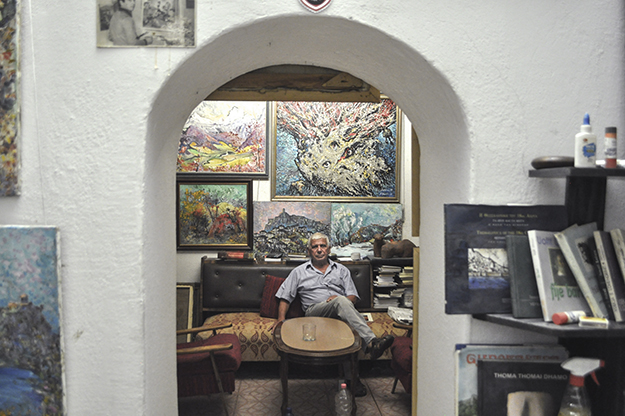
Arben Basha, here surrounded by his work in his studio in Tirana, worked for over 20 years under the Hoxha regime. Photo: Lorina Hoxha / K2.0.
The walls in Basha’s personal studio in Tirana are now covered with expressionist landscape paintings, a style he would not have been permitted to paint in before 1990. It’s now nearly 50 years since the beginning of his career. Asked whether he was aware that he was making propaganda under Hoxha, Basha answers slowly, but honestly. “Yes. Yes, of course I knew this. But you couldn’t do otherwise. You had to do the work. You had to eat. You had a family.”
An ever-changing regime
In Hoxha-era Albania, artistic production was always intimately tied to the inner conflicts of the state. Isa Blumi, an associate professor at the University of Stockholm and specialist on Albania, notes that each time the Hoxha regime changed its orientation, whether it be turning its back on the USSR, or Mao’s China, there was a purge of the existing political elite, and new dictates were subsequently imposed over cultural life.
By 1961, after breaking ties with the Soviet Union, Hoxha had ensured that Albania was well on its way to becoming the most isolationist state in the world. His first action was to implement an ideological campaign of “communist education,” from which “a new person with new ideas, with exalted virtues and high morals” would emerge. In a 1965 speech, Hoxha declared writers and artists to be “the educators of the masses.”
Albanian socialist realist art, much like socialist realist art in general, emerged in service of political ideology, but it was also unique as a result of the state’s more extreme isolationism in comparison to the rest of the Eastern Bloc. Albanian socialist realism was concerned with depicting Albania as if on the threshold of a new era, and there were several new ‘eras’ during Hoxha’s 40-year reign. With every new reorientation, those loyal to the previous generation of leadership were deemed dangerous by the state.
When Basha began working at Kinostudio in 1970, it was during a time that is now remembered as the period of ‘liberalization.’ This supposedly more open period ended with the 1973 “Purge of Liberals,” a campaign that marked the beginning of the Sino-Albanian split, which saw many artists accused of anti-conformism and some punished with imprisonment, exile, internment, and even execution. While many remember this as the beginning of an era of extreme state repression over cultural life, Blumi rejects this narrative.
“The so-called period of liberalization is not one at all,” he explains. “It is just a generation of artists who worked for the regime at the time, who were then either removed, or forced to publicly repudiate their past.”
Blumi warns that the mischaracterization of this period is a fixture of a revisionist history of Albania that continues to be written by those that survived to see the 1990s and suffered under the 1973 transition of power. “These artists would claim, as victims of the Hoxha regime, to be liberals; of course since they were jailed in 1973 during the purge, they must be seen by us retrospectively as good anti-Hoxha artists, bravely challenging the regime that clamped down on them,” he states. “This is nonsense. They were conformists and were following party dictates in the late 1960s, and were only caught in the transition of internal power.”
Rather than being persecuted because they represented any dissident tendencies, Blumi stresses that many artists were persecuted simply because they were propagandists for the previous generation of Hoxha regime elites, and their work had become obsolete and contradictory by the new standards of the regime. “[They] were victims of changing times, not of conflicting morals or ethics,” he argues.
“The Worker” as ideal citizen
The central figure of Albanian society, and consequently of socialist realist art, was “the Worker”: the heroic figure who toiled every day to build a new Albania. It was in part through the careful establishment of “the Worker” as the ideal model citizen that the regime monopolized its coercive power. To adhere to the model of “the Worker” was to receive the State’s protection. The bottom line, Blumi says, was “conform like this worker, and you eat too.”
Artistic depictions were among the most important ways that this coercive message was transmitted. Basha, who several times had his paintings criticized by gallery officials, says it wasn’t just enough to feature workers in your piece, but “you had to be careful about how you made these workers look. Were they muscular and healthy? Did they show any sign of unhappiness?”
It was this precautionary fear over every detail of a painting that clouded Basha’s career under Hoxha’s regime. He says it was impossible to get a painting accepted into a gallery showing if even one element of it could be suspected of being non-conformist in its violation of stylistic rules.
As to what these ‘rules’ actually entailed, Basha says they ranged from the colours used to the time of day the painting was set. Bright colours translated to optimism about the future of the nation, such that workers would often be depicted in the daytime, “under the Socialist sun,” Basha says with a chuckle, quoting one of his past art critics. By contrast, subdued tones were cause for suspicion.
Exhibition politics
In 1986, Basha had a painting rejected in an exhibition because his subject did not look ‘optimistic’ enough about the Communist Party’s ability to bring Albania to greatness.
However, just a few years later in the early ’90s, when the regime was near its end, Basha says he completed a painting depicting a girl and a boy on a train track, happily running out of a tunnel and into the light. He was implicitly celebrating the coming of democracy, but even at the time, gallery officials were wary of his depictions of communism as a dark time, and rejected it. “I made a mistake and ripped it apart,” he says, “I was afraid at the time. I didn’t want to end up in prison, where I’d seen so many end up.”
Frustrated, Basha eventually distanced himself from political paintings and became a landscape painter. “With landscapes, no one was going to ask me why I painted the tree red or why it’s slanted. But if I kept painting portraits, they’d scrutinize me for every possible detail.”
The first time Basha had a painting accepted for exhibition at the National Gallery was in a group exhibition with Edi Hila and Edison Gjergo in 1972, the last year before the regime’s ties with the increasingly toxic Chinese leadership began to disintegrate. Basha says that despite the attention the show was getting from the gallery and art critics, he was wary of doing interviews at the time. Looking back now, he wonders if this is what spared him.
By the mid-’70s, the painters were condemned for anti-conformism. Edison Gjergo was imprisoned, and Edi Hila was interned, while Basha was spared. “I went home and burned ten of my paintings,” he says.
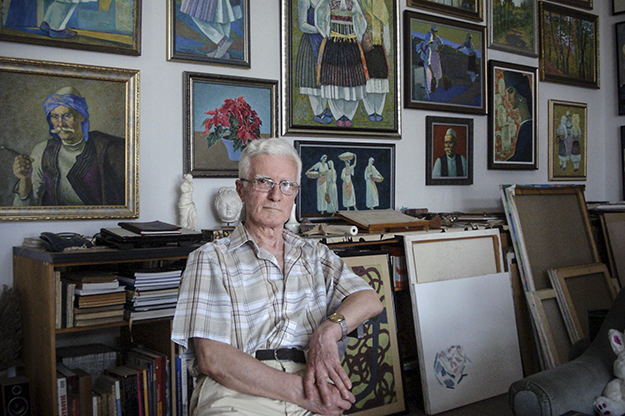
Zef Shoshi claims that there are many creative works from the Hoxha era that remain precious to Albania’s art history. Photo: Lorina Hoxha / K2.0.
Despite the fact that many artists look back bitterly on the Hoxha era, there are still some who will defend the merits of the work made at the time. One of them is Zef Shoshi, most famously known for his portrait of Enver Hoxha. Shoshi still works every day at his spacious studio on the top floor of an apartment building near Sheshi Medreseja in Tirana, an area where many artists settled in the ’70s.
“Everyone says ‘dictatorship, dictatorship,’ but out of that dictatorship emerged some truly valuable works. Naturally, they served an ideology, but there are still paintings that are wholly realist, that you could not label as socialist,” Shoshi says, offering the mural on the National Historical Museum in Tirana as an example.
The paintings hung in Shoshi’s studio are a testament to his longstanding commitment to this tradition. Describing himself as an artist “shaped by the regime,” it is evident that Shoshi seldom felt the desire to stray from it, given how little his work from after the regime varied in its subjects, settings, and style. This, Shoshi mentions, made it difficult for him to integrate into the post-1990 art world, and he still struggles to find his place, now making his living off of commissions.
Since his early days visiting the Zadrima region of Albania in 1955 and sketching the villagers at work, the central subjects of Shoshi’s paintings have been people in their day-to-day activities. “Naturally,” he says, “I’ve had some desire to make a work that is a little different, but I have continued to treat my work and its subjects in a realist style. While at that time I would paint the people of Zadrima working, now I’ve freed them from the occasion of work or I do them differently, but it is still them that I am focused on. It is with those subjects that I continue to work.”
When asked how he feels about being known as a painter of the regime, Shoshi responds: “All painters in every century have worked for their kings. Velasquez did several portraits of King Philip IV, and he is now known as one of the world’s greatest realist painters.”
“I don’t regret doing portraits of Enver Hoxha at all,” Shoshi goes on, “those are historical works. There will come a time when people will look at those portraits and won’t immediately think ‘he painted the dictator’ and dismiss them.”
For Shoshi, the devaluation of socialist realist art is really a function of time. Rather than “liberate themselves from politics,” and evaluate artworks as artworks alone, many continue to see his works, especially his portraits of Enver Hoxha, as little more than propaganda.
This is an issue of recent frustration for Shoshi, who had an exhibit in Kosovo’s National Art Gallery in April, where he was supposed to show his portrait of Enver Hoxha, until it was pulled out of the show last minute. “The media began to criticize the gallery,” Shoshi explains, “saying ‘there goes Zef Shoshi sending his portrait of Enver Hoxha to Kosovo.’ So the portrait wasn’t exhibited. The political standpoint remains, so some time still needs to pass before people are freed from this perspective.”
Painting women’s emancipation
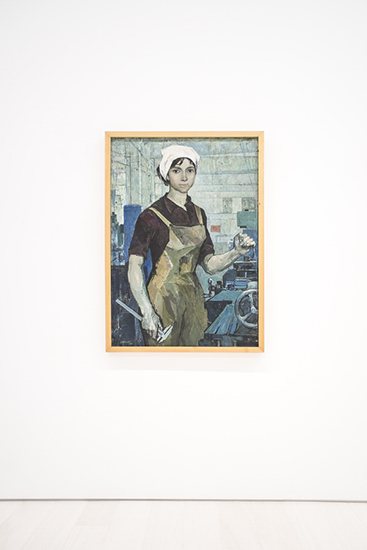
Shoshi painted a number of women in his depictions of rural Albanian life, including “The Turner” in 1969. Photo: Mathias Volzke.
Both Shoshi and Basha are known for their portraits of women during Albania’s campaign for the ‘Emancipation of Women,’ which was premised on the idea that women’s liberation would be achieved through their inclusion in a new and unified working class.
Paintings of women at work were an important fixture of the iconography of that period, including Shoshi’s painting from 1969, titled “The Turner.”
When asked whether he had any political message in mind when painting this portrait, Shoshi seems aware that his painting was inarguably tethered to a certain politics, but sees those politics as separate from the art itself, the latter of which is the only thing he claims responsibility for. “As with other artists, I worked with the themes that the time demanded,” he explains.
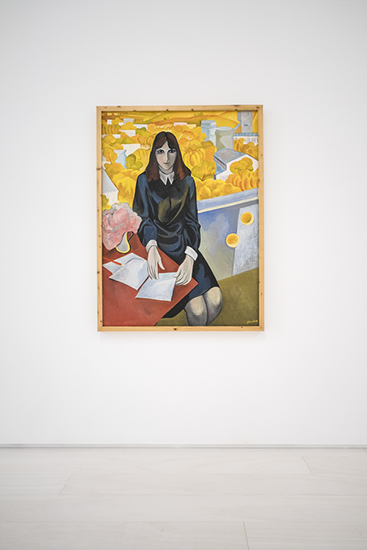
Arben Basha’s “I Will Write” intended to portray the subject as a witness to Albanian society. Photo: Mathias Volzke.
Basha’s portrait of a young woman from the same period, titled “I Will Write,” was bought by the National Gallery, but never exhibited. While most paintings of the time depicted young women working in fields or factories, Basha painted a schoolgirl sitting at a table, with a blank page in front of her and a pen in hand.
“They accused me of hermeticism when I first tried exhibiting it in the ’70s. They thought the meaning wasn’t clear, and the Party always wanted the meaning to be clear,” Basha says.
When asked about the title, Basha responds, “I wanted to paint her as a powerful witness, as if she is looking at the country and saying: ‘Will you do good for this place? I will write. Will you do bad for this place? I will write.’”
Still, the pressure Basha felt at the time to conform to the Party’s aesthetic standards are evident in the painting’s background, where a lush industrial landscape filled with silos and factories can be seen bathed in golden light. “There are very clear socialist realist themes in this painting. I was young, just out of school, and still believed in some of it,” Basha admits.
After the mid-’70s crackdown that sent many artists to prison, Basha’s painting disappeared, only re-emerging in 2000, when the National Gallery of Art in Tirana set up a permanent exhibition of period paintings.
Albanian communist cinema
Many of the ideological demands Basha had to adhere to in his paintings similarly applied to the films he worked on as part of Kinostudio.
The first film Basha was involved in was titled “The Calling” (1976), which followed the journey of an intellectual professor who set out to work in a rural village, where he encountered the backward mentalities of villagers. The actress that played the secretary of the Party in the film, Basha says, was Justina Alia, who had performed a song in praise of liberalization at a Song Festival in Tirana in the early ’70s before the 1973 transition of power.
In 1975, a month into filming “The Calling,” Party officials removed Alia from the role by force because the song she had sung years before was now deemed anti-conformist. She was subsequently banned from acting and singing.
“That was Enver Hoxha,” Basha says with a grimace.
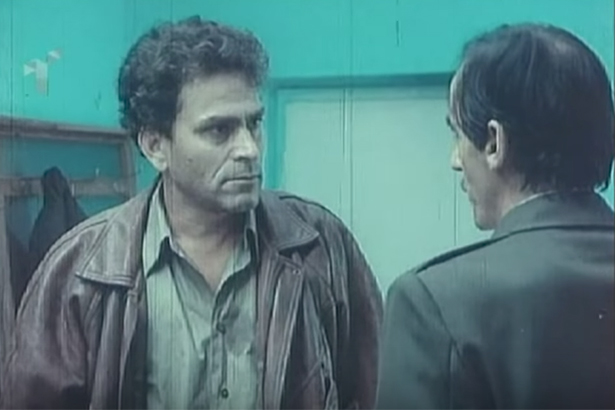
Films such as “The Death of the Horse” managed to avoid heavy censorship as the Party’s grip on cultural institutions loosened in the early 1990s.
By the early 1990s, with the regime coming to its end, there was no longer the same constraints on cultural production as in the decades before, but the transition to democracy was clouded with uncertainty and filmmakers were still afraid of persecution.
A film Basha was working on at the time, “The Death of the Horse” (1992), ended with the protagonist being unfairly denounced by the Party and sent to prison. “I went to the director and asked him if we could put in a final scene, when democracy has arrived, and the protagonist is let out,” Basha reveals.
The scene Basha envisioned had the protagonist walking through the streets of Tirana, watching the democratization protests, and eventually encountering the former Party official who landed him in prison, who was now running for office in the new democracy. “Of course, it was a very bitter final scene, but one that spoke to the reality.”
When Basha pitched this to the director, he was told no. The director was firm about his screenplay ending where it did, telling Basha to write the scene himself if he was willing to take responsibility for it.
“He was afraid,” Basha says. “But by 1992, things had become better — there was no Party commission evaluating your films anymore. And so we filmed the scene. And I still think that’s the most beautiful scene of the movie.”
Interrogating memory
Enver Hoxha’s definition of the purpose of art was that it would reflect social relations — that in art, “the pulse of the life and struggle” of the people would be felt. While Basha, whose paintings occasionally deal with political issues, would not necessarily disagree with such a statement, he flatly rejects that this was what socialist realism was doing.
“It would be a mistake to look at the art made during the period as a representation of how Albania was,” Basha says. “It was how Albania was supposed to be in the eyes of totalitarian communist doctrine. The reality was very different — and we were seeing all of it, those of us who worked at Kinostudio. As a painter, while you may have painted the villager working happily with a pickaxe, in reality he didn’t have any food to eat at home.”
This is a reality that even someone like Shoshi could not deny. “Yes we were poor,” Shoshi says, “but we were simple. The time will come when the things that happened will be appraised, and not just the bad things. That regime created a lot of good things too, and we have inherited it all.”
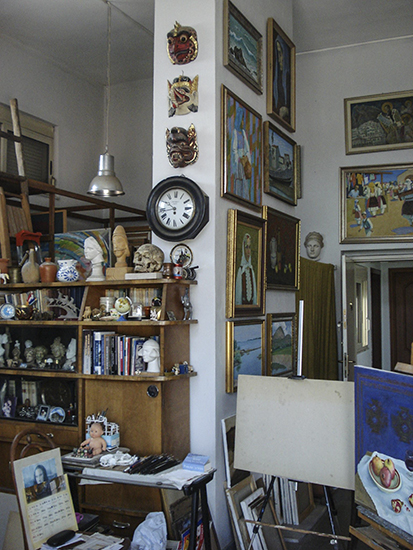
Shoshi keeps the belongings of his late father in his studio in Tirana, alongside older paintings of his own. Photo: Lorina Hoxha / K2.0.
Though distancing his work from the politics of the time, Shoshi’s retelling of his experiences cannot help but betray a deep admiration for Enver Hoxha, which despite starkly contrasting Basha’s painful accounts, is a feeling that he is far from alone in harboring.
Despite having completed multiple portraits of Hoxha, Shoshi was never actually ordered to do so, and had almost no contact with him throughout his entire life. His only meaningful meeting with Hoxha, he says, had been in his early youth as a pioneer, when he had visited Hoxha’s native Gjirokaster during a tour and showed the leader his sketches.
Other than this meeting, Shoshi says he had only seen Hoxha in passing at gallery shows, and he recounts one particular exhibit of his that Hoxha had attended. “I gave him my hand, and he said to me, ‘may you always stay as young as you are’,” Shoshi recites, his eyes welling up.
Almost 30 years since the regime’s end, nostalgia like that of Shoshi’s persists, and the memory of Hoxha continues to elicit emotional responses. In many ways, it appears as if Shoshi and Basha lived two different realities, both of which were far from the worst reality of the time, yet testaments to a severe division in experience between those who were devout followers of Hoxha’s ‘good working class’ and those who were threatened with expulsion from it.
In post-communist Albania, where those victimized by the regime live alongside their executioners, the impossibility of dialogue that might bridge these two enclosed realities makes the issue of remembrance difficult to navigate.
“For many, the regime happened alongside the days of their youth,” Basha says. “And when remembering our youth, we tend to dwell on its beauty.”K
Feature image: Lorina Hoxha / K2.0.







